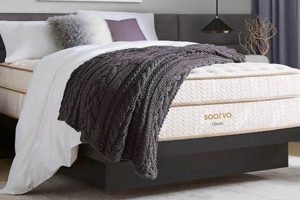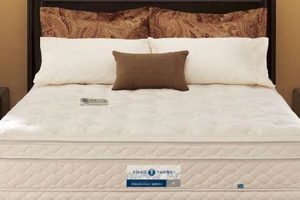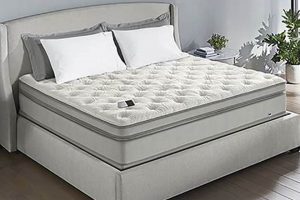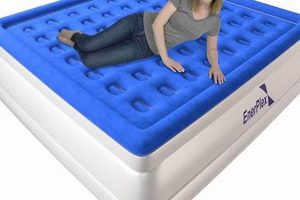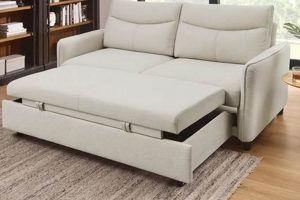A portable bedding solution designed for convenient storage and transport is frequently constructed from foam or other resilient materials. This type of mattress is engineered to collapse into a smaller, more manageable form through a series of folds. An example includes a tri-fold mattress used for accommodating overnight guests in limited spaces or for camping.
The utility of these items lies in their space-saving design and ease of use. They provide a readily available sleeping surface without the need for permanent bed frames or extensive storage areas. Historically, simpler versions were used in military contexts or during travel where comfort was secondary to portability. Modern iterations prioritize both comfort and convenience, employing advanced materials for improved sleep quality.
The following sections will delve into various aspects related to these adaptable sleep solutions, including material composition, size and thickness considerations, suitable applications, maintenance procedures, and a comparison of different types available on the market.
Tips for Selecting and Maintaining a Folding Sleeping Mattress
Optimizing the lifespan and utility of a portable sleep solution requires careful consideration during selection and consistent adherence to proper maintenance procedures. The following tips offer guidance for maximizing the value of this type of bedding.
Tip 1: Evaluate Material Composition: Prioritize options utilizing high-density foam or memory foam for superior support and comfort. Consider hypoallergenic materials to minimize potential allergic reactions.
Tip 2: Assess Thickness and Dimensions: Select a thickness appropriate for the intended use. Thicker options generally offer improved comfort for extended use. Verify dimensions align with available space and portability requirements.
Tip 3: Inquire About Fold Mechanism Durability: Examine the hinge or folding mechanism to ensure smooth operation and resistance to wear and tear. Reinforced stitching and robust materials contribute to longevity.
Tip 4: Inspect Cover Fabric Quality: Opt for a cover fabric that is both durable and breathable. Consider water-resistant or waterproof options for outdoor use or environments prone to spills.
Tip 5: Implement Regular Cleaning Practices: Vacuum the mattress surface frequently to remove dust and debris. Follow manufacturer instructions for spot cleaning or deep cleaning procedures. Promptly address spills to prevent staining and odor buildup.
Tip 6: Rotate and Flip Periodically: Distribute wear evenly by rotating and flipping the mattress regularly. This practice helps prevent sagging and prolongs its overall lifespan.
Tip 7: Store Properly When Not in Use: Store the mattress in a dry, well-ventilated area to prevent mildew and odor development. Consider using a storage bag to protect it from dust and pests.
Adherence to these guidelines ensures optimal comfort, longevity, and hygiene for a portable sleep solution. Selecting the appropriate materials, dimensions, and fold mechanism, combined with consistent maintenance, will contribute to a more satisfying and durable product.
The subsequent section will address common misconceptions regarding portable sleep solutions and provide clarification based on current industry standards and best practices.
1. Portability
The concept of portability is intrinsically linked to the design and application of a folding sleeping mattress. Its ability to be easily transported is a primary factor driving its adoption in various settings. This inherent characteristic dictates material choices, construction methods, and overall design considerations.
- Reduced Size and Weight
The folding mechanism inherently reduces the overall footprint of the mattress when not in use, enabling easy storage and transportation. The implementation of lightweight materials, such as specific types of foam, further enhances portability. The reduced weight makes it feasible for a single individual to manage and transport the mattress.
- Compact Storage
The ability to fold into a compact form factor allows for efficient storage in areas where space is limited. This is particularly advantageous in apartments, dormitories, or vehicles where maximizing available space is crucial. Certain models include carrying cases or straps to further facilitate storage and transport.
- Versatile Applications
The portable nature of these mattresses facilitates their use in a wide array of situations. These include camping trips, accommodating overnight guests, providing temporary bedding in emergency situations, and creating comfortable sleeping surfaces in vehicles. Its adaptability extends its utility across diverse environments and needs.
- Ease of Deployment and Storage
The simple folding and unfolding process allows for rapid deployment and storage. This ease of use contributes significantly to its portability, as it eliminates the complexities associated with setting up and dismantling traditional bedding. This streamlined process is particularly valuable in situations where time and effort are limited.
The facets outlined above demonstrate the central role portability plays in defining the functionality and appeal of a folding sleeping mattress. Its ability to be easily transported, stored, and deployed renders it a versatile solution for a wide spectrum of applications, thereby addressing the needs of individuals seeking a convenient and adaptable bedding option. The continued refinement of lightweight materials and folding mechanisms will further enhance the portability and broaden the appeal of these mattresses.
2. Space Efficiency
The inherent design of a folding sleeping mattress directly addresses the need for space efficiency in residential, recreational, and emergency contexts. The ability to compress a standard sleeping surface into a significantly smaller volume when not in use constitutes a primary driver for its adoption. This feature is not merely a convenience; it is a critical factor in environments where square footage is limited or storage options are constrained. The causal relationship is direct: the folding mechanism allows for compression, which, in turn, optimizes space utilization. A practical example is the use of these mattresses in studio apartments, where converting a living area into a bedroom necessitates maximizing available space during daytime hours. Similarly, in recreational vehicles, the foldable nature enables comfortable sleeping arrangements without permanently sacrificing living space.
The importance of space efficiency as a component of the mattress is further underscored by its impact on logistical considerations. Storage costs, transportation expenses, and ease of handling are all directly influenced by the compressed volume of the folded mattress. For instance, disaster relief organizations frequently deploy these mattresses in temporary shelters. The ability to store and transport a large quantity of beds in a compact form is essential for rapid response and efficient resource allocation. The practical significance lies in the ability to provide comfortable and sanitary sleeping arrangements quickly and effectively, even in environments with limited infrastructure.
In summary, the space efficiency afforded by a folding sleeping mattress transcends mere convenience. It represents a functional necessity in diverse scenarios ranging from urban living to emergency response. The folding mechanism, coupled with appropriate material selection, enables the creation of comfortable, portable sleeping solutions that minimize spatial demands. The continued optimization of folding mechanisms and material technologies will likely further enhance the space-saving capabilities, thereby solidifying the value proposition of these mattresses in space-conscious environments.
3. Material Composition
The selection of materials directly dictates the performance characteristics of a folding sleeping mattress, influencing its comfort, durability, portability, and overall suitability for specific applications. The relationship is causative: material properties determine the degree of support, the ease of folding and unfolding, and the mattress’s resistance to wear and tear. For example, a mattress constructed with high-density memory foam offers enhanced pressure relief and conforms to the body’s contours, promoting a more restful sleep. However, high-density foam may also increase the mattress’s overall weight, potentially compromising its portability. Conversely, a mattress made with less dense polyurethane foam is lighter and easier to maneuver but may provide inadequate support for individuals with back pain or those requiring a firmer sleeping surface. Thus, material choices represent a critical trade-off between competing performance attributes.
The importance of material composition extends beyond comfort and support to encompass factors such as hygiene and environmental impact. Certain materials, such as latex or open-cell foam, exhibit inherent antimicrobial properties, inhibiting the growth of bacteria and mold. This is particularly relevant in environments where the mattress is exposed to moisture or humidity, such as during camping trips or in temporary shelters. Additionally, the use of recycled or sustainably sourced materials can reduce the environmental footprint of the mattress, aligning with growing consumer demand for eco-friendly products. The practical significance of this understanding lies in enabling consumers to make informed purchasing decisions that prioritize not only comfort and convenience but also health and environmental considerations. This also extends to specific industry applications where the selection can be based on the types of usage. For instance, in hospitals, antimicrobial and easily cleanable materials are favored.
In summary, the composition of a folding sleeping mattress is not merely a matter of aesthetic preference; it is a fundamental determinant of its functionality, durability, and suitability for various applications. The careful selection of materials requires a thorough understanding of their respective properties and their impact on the mattress’s overall performance. Balancing considerations such as comfort, portability, hygiene, and environmental impact is crucial for creating a product that meets the diverse needs of consumers and specific industry requirements. Challenges remain in developing materials that simultaneously optimize all these attributes, but ongoing innovation in materials science holds the promise of creating folding sleeping mattresses that are both comfortable, durable, sustainable and adaptable.
4. Thickness options
The selection of an appropriate thickness is a critical determinant of comfort, support, and overall usability when considering a folding sleeping mattress. Available thickness options significantly impact the suitability of the mattress for various applications and user preferences. A direct correlation exists between thickness, weight, and portability, necessitating careful consideration of trade-offs.
- Impact on Comfort and Support
Increased thickness generally correlates with enhanced comfort and support due to the greater volume of cushioning material. Thicker mattresses can more effectively distribute weight and reduce pressure points, leading to a more restful sleep. However, excessively thick mattresses may compromise the folding mechanism and reduce portability, impacting their overall functionality. For example, a mattress intended for frequent travel may prioritize thinner profiles for ease of transport, sacrificing some degree of comfort compared to a thicker option designed for occasional guest use.
- Influence on Portability and Storage
Thickness directly affects the folded dimensions and weight of the mattress, thereby influencing its portability and storage requirements. Thicker mattresses inherently occupy more space when folded, potentially limiting their suitability for applications where storage space is at a premium. The added weight may also pose challenges for individuals with mobility limitations or when transporting the mattress over long distances. Consequently, a balance must be struck between comfort and convenience, with thinner options often favored for situations demanding maximum portability.
- Adaptability to Different Sleeping Surfaces
The thickness of a folding sleeping mattress can influence its adaptability to various sleeping surfaces. Thicker mattresses are generally more forgiving of uneven or rigid surfaces, providing a greater degree of cushioning and minimizing discomfort. Conversely, thinner mattresses may be more susceptible to the contours of the underlying surface, potentially leading to pressure points and compromised sleep quality. The choice of thickness should therefore be guided by the anticipated sleeping environment, with thicker options preferred for uneven or unforgiving surfaces.
- Correlation with Cost and Durability
Material volume used in the construction of a folding sleeping mattress directly correlates with its cost. Thicker mattresses typically require more material, leading to a higher price point. However, increased material volume can also enhance durability, as thicker mattresses may be more resistant to compression and wear over time. Consequently, consumers should weigh the initial investment against the expected lifespan and performance of the mattress, considering factors such as material quality, construction methods, and intended usage patterns.
In summary, the selection of an appropriate thickness for a folding sleeping mattress represents a multifaceted decision involving considerations of comfort, portability, surface adaptability, cost, and durability. The ideal choice depends on the intended application, user preferences, and the specific trade-offs deemed acceptable. Careful evaluation of these factors is essential for maximizing the value and utility of this versatile bedding solution.
5. Fold mechanism
The fold mechanism constitutes an integral element in the design and functionality of a folding sleeping mattress. Its reliability and efficiency directly impact the user experience, storage convenience, and overall longevity of the product. Therefore, a comprehensive understanding of the various types of fold mechanisms and their respective strengths and weaknesses is essential for both manufacturers and consumers.
- Hinge Durability and Type
The type of hinge employed significantly affects the mattress’s durability and ease of folding. Options range from simple fabric hinges to more robust metal or plastic hinges. Fabric hinges may offer greater flexibility but are prone to wear and tear, especially with frequent use. Metal hinges provide superior durability but can add weight and complexity to the folding process. The choice of hinge type should be aligned with the intended frequency of use and the desired level of durability. For example, a mattress designed for daily use would benefit from a more durable metal hinge, while a mattress intended for occasional use may suffice with a fabric hinge.
- Folding Configuration and Compactness
The folding configuration dictates the folded dimensions of the mattress and its subsequent storage efficiency. Common configurations include bi-fold, tri-fold, and roll-up designs. Bi-fold mattresses offer simplicity but may not achieve the same level of compactness as tri-fold designs. Roll-up mattresses provide maximum compactness but can be less comfortable due to the compression of the internal materials. The selection of a folding configuration should be based on the available storage space and the desired balance between compactness and comfort. A studio apartment, for instance, may benefit from a tri-fold mattress to maximize storage space, while a camping scenario may favor a roll-up design for ease of transport.
- Locking Mechanisms and Stability
Locking mechanisms are essential for maintaining the mattress’s structural integrity when unfolded. These mechanisms prevent unintended folding during use, ensuring a stable and secure sleeping surface. Options include Velcro straps, buckles, and snap closures. The effectiveness of the locking mechanism directly impacts the user’s safety and comfort. A poorly designed or unreliable locking mechanism can lead to instability and potential injury. Therefore, the selection of a locking mechanism should prioritize security and ease of use. For example, a mattress intended for use by children should incorporate a robust locking mechanism that is difficult to disengage unintentionally.
- Weight Distribution and Support
The fold mechanism can influence the weight distribution and support characteristics of the mattress. The placement of hinges and the design of the folding configuration can create pressure points or areas of uneven support. This is particularly relevant in tri-fold mattresses, where the central panel may experience greater stress than the outer panels. Manufacturers should carefully consider these factors when designing the fold mechanism to ensure uniform support across the entire sleeping surface. Proper weight distribution is crucial for maintaining spinal alignment and preventing discomfort. For instance, a mattress designed for individuals with back pain should incorporate a fold mechanism that minimizes pressure points and promotes even weight distribution.
In conclusion, the fold mechanism represents a critical design element that significantly impacts the functionality, durability, and user experience of a folding sleeping mattress. Careful consideration of hinge type, folding configuration, locking mechanisms, and weight distribution is essential for creating a product that meets the diverse needs of consumers. Continuous innovation in fold mechanism design will undoubtedly contribute to the enhanced comfort, convenience, and longevity of these versatile bedding solutions.
6. Support levels
The support level provided by a folding sleeping mattress is a primary determinant of its suitability for diverse individuals and applications. The internal construction and materials directly influence the mattresss ability to maintain spinal alignment and distribute weight evenly, thus impacting sleep quality and minimizing discomfort. Insufficient support can lead to pressure points, muscle strain, and, in the long term, potential musculoskeletal issues. Conversely, adequate support ensures that the spine remains in a neutral position throughout the night, promoting proper circulation and reducing the likelihood of aches and pains. A practical example includes a folding mattress used for temporary accommodation; a high-density foam core would provide superior support compared to a low-density option, especially for individuals with pre-existing back conditions. The practical significance of understanding support levels lies in enabling informed purchasing decisions that prioritize comfort and long-term health.
Variations in support levels are often achieved through differing material compositions, such as the incorporation of memory foam, gel-infused foam, or innerspring systems within the folding mattress structure. Memory foam, for example, conforms to the body’s contours, providing customized support and pressure relief. Gel-infused foam dissipates heat, enhancing comfort, particularly in warmer climates. Innerspring systems, while less common in folding mattresses due to their bulk, offer a more traditional level of support and firmness. The optimal support level is subjective and dependent on factors such as body weight, sleeping position, and personal preferences. Side sleepers, for instance, typically require a softer mattress to cushion the shoulders and hips, while stomach sleepers benefit from a firmer surface to prevent spinal misalignment. The need of user has a direct relation to design of mattress for level of support.
In summary, the support level is a critical performance attribute of a folding sleeping mattress, influencing comfort, spinal health, and overall user satisfaction. The selection of an appropriate support level necessitates careful consideration of individual needs, preferences, and the intended application of the mattress. Ongoing advancements in material science and mattress design continue to refine the range of support options available, enabling consumers to find solutions that best address their specific requirements. A challenge exists in balancing support with portability and compactness, but innovative folding mechanisms and material combinations are continuously pushing the boundaries of what is achievable.
7. Storage needs
The logistical demands associated with the storage of a sleeping surface are significantly influenced by its form factor. In the context of a folding sleeping mattress, storage needs become a primary consideration, dictating design choices and impacting user convenience. The folding mechanism inherently addresses these needs, but specific requirements vary based on usage frequency, available space, and environmental conditions.
- Minimizing Footprint
The primary benefit of a folding sleeping mattress is its ability to compress into a smaller volume for storage. This minimizes the spatial footprint when the mattress is not in use, making it suitable for environments with limited storage capacity, such as apartments, dormitories, and recreational vehicles. The folded dimensions directly impact the ease of storing the mattress in closets, under beds, or within designated storage compartments.
- Protection from Environmental Factors
Proper storage safeguards the mattress from potential damage caused by moisture, dust, pests, and sunlight. Damp environments can promote mold growth, compromising hygiene and shortening the lifespan of the mattress. Dust accumulation can trigger allergies and degrade material quality. Direct sunlight can fade colors and weaken fabrics. Appropriate storage solutions, such as storage bags or protective covers, mitigate these risks.
- Accessibility and Convenience
Storage location should balance protection with accessibility. A frequently used folding sleeping mattress necessitates a storage location that allows for quick and easy deployment. Conversely, a mattress used only occasionally may be stored in a more remote or less accessible location. Convenience factors, such as the weight and bulk of the folded mattress, influence the suitability of different storage options. Storage on a high shelf, for example, may be impractical for individuals with limited strength or mobility.
- Organization and Aesthetics
The storage of a folding sleeping mattress contributes to the overall organization and aesthetic appeal of a living space. A neatly stored mattress reduces clutter and enhances the visual harmony of the environment. Dedicated storage solutions, such as custom-built cabinets or storage benches, can integrate the mattress seamlessly into the existing decor. Conversely, a haphazardly stored mattress can detract from the overall aesthetic and create a sense of disorganization.
The multifaceted storage needs associated with a folding sleeping mattress underscore the importance of considering logistical factors during the purchasing process. The ability to effectively store and protect the mattress directly impacts its long-term usability and contributes to the overall satisfaction of the user. Proper storage solutions, tailored to the specific needs and constraints of the environment, are essential for maximizing the value and longevity of this versatile bedding option.
Frequently Asked Questions
The following section addresses common inquiries regarding folding sleeping mattresses, providing clear and concise answers to assist with informed decision-making.
Question 1: What materials are typically used in a folding sleeping mattress?
Folding sleeping mattresses commonly utilize polyurethane foam, memory foam, or a combination thereof. Cover materials often consist of durable fabrics such as polyester or cotton blends. The choice of materials affects comfort, support, and overall lifespan.
Question 2: What is the typical lifespan of a folding sleeping mattress?
Lifespan varies depending on the quality of materials and frequency of use. With proper care, a high-quality folding sleeping mattress can last for several years. Regular cleaning and appropriate storage contribute to longevity.
Question 3: Are folding sleeping mattresses suitable for everyday use?
While designed primarily for occasional use, some higher-quality folding sleeping mattresses offer sufficient comfort and support for daily use. Consider factors such as foam density and thickness when evaluating suitability for everyday use.
Question 4: How should a folding sleeping mattress be cleaned?
Cleaning procedures depend on the specific materials. Generally, vacuuming the surface regularly is recommended. Spot cleaning with a mild detergent and water may be necessary for stains. Always refer to the manufacturer’s instructions for specific cleaning recommendations.
Question 5: What is the optimal thickness for a folding sleeping mattress?
Optimal thickness depends on the intended use and individual preferences. Thicker mattresses generally offer greater comfort and support, while thinner mattresses prioritize portability. A thickness of at least 4 inches is recommended for most adults.
Question 6: How should a folding sleeping mattress be stored to prevent damage?
Store the mattress in a dry, well-ventilated area to prevent mold and mildew growth. Using a storage bag or cover can protect the mattress from dust, pests, and sunlight. Avoid storing heavy objects on top of the mattress to prevent compression damage.
These FAQs provide a foundational understanding of folding sleeping mattresses. Careful consideration of these factors facilitates a more informed selection process.
The following section will summarize the key benefits and drawbacks associated with folding sleeping mattresses, providing a balanced perspective on their overall utility.
Conclusion
The preceding analysis has elucidated the multifaceted nature of the folding sleeping mattress, encompassing its design parameters, material considerations, and diverse applications. Key points include its inherent portability, space-saving attributes, and the critical role of material composition in determining comfort and durability. The selection process necessitates a thorough evaluation of individual needs, prioritizing factors such as support requirements, storage constraints, and anticipated usage patterns.
The continued evolution of material science and folding mechanisms will undoubtedly enhance the performance and versatility of these mattresses. As societal trends increasingly favor adaptable living spaces and mobile lifestyles, the significance of the folding sleeping mattress as a pragmatic and efficient sleep solution will only continue to grow. Further research and development should focus on optimizing the balance between comfort, durability, and portability to meet the evolving demands of a dynamic consumer base.


